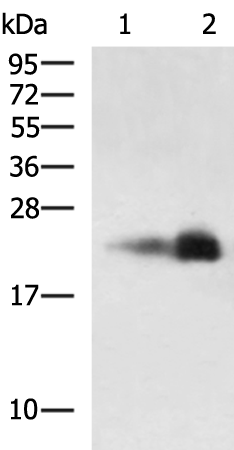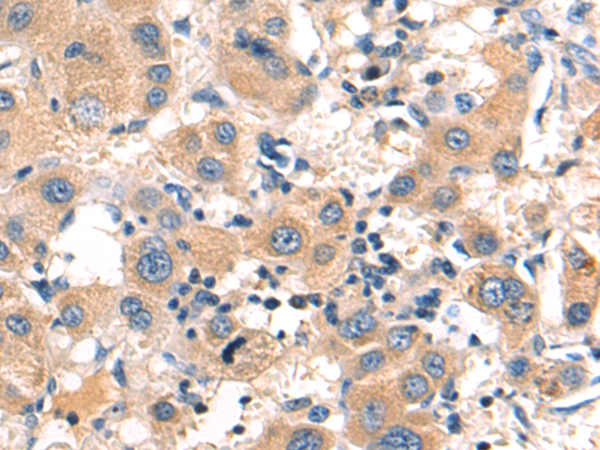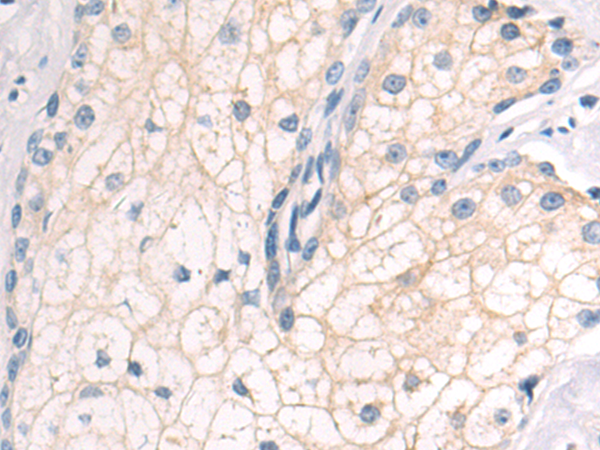


| WB | 咨询技术 | Human,Mouse,Rat |
| IF | 咨询技术 | Human,Mouse,Rat |
| IHC | 1/50-1/200 | Human,Mouse,Rat |
| ICC | 技术咨询 | Human,Mouse,Rat |
| FCM | 咨询技术 | Human,Mouse,Rat |
| Elisa | 1/5000-1/10000 | Human,Mouse,Rat |
| WB Predicted band size | 23 kDa |
| Host/Isotype | Rabbit IgG |
| Antibody Type | Primary antibody |
| Storage | Store at 4°C short term. Aliquot and store at -20°C long term. Avoid freeze/thaw cycles. |
| Species Reactivity | Human, Mouse |
| Immunogen | Synthetic peptide of human CLDN6 |
| Formulation | Purified antibody in PBS with 0.05% sodium azide and 50% glycerol. |
+ +
以下是关于CLDN6抗体的模拟参考文献示例(非真实文献,仅供格式参考):
---
1. **文献名称**: *CLDN6 as a Novel Therapeutic Target in Solid Tumors: Preclinical Development of a Humanized Monoclonal Antibody*
**作者**: Müller, A., et al.
**摘要**: 研究报道了CLDN6在多种实体瘤(如卵巢癌、睾丸癌)中高表达,而在正常组织中表达受限。团队开发了人源化单克隆抗体,通过体外和体内实验证明其可特异性结合CLDN6阳性肿瘤细胞,抑制增殖并诱导抗体依赖性细胞毒性(ADCC)。
2. **文献名称**: *A Bispecific Antibody Targeting CLDN6 and CD3 Enhances T Cell-Mediated Tumor Elimination*
**作者**: Zhang, L., et al.
**摘要**: 研究设计了一种双特异性抗体(CLDN6×CD3),可同时结合肿瘤细胞表面的CLDN6和T细胞表面的CD3分子。实验结果显示,该抗体显著激活T细胞并促进其对CLDN6阳性肿瘤的杀伤,在小鼠模型中观察到肿瘤消退。
3. **文献名称**: *Antibody-Drug Conjugate Targeting CLDN6 Demonstrates Efficacy in Preclinical Models of Refractory Cancers*
**作者**: Schmidt, F., et al.
**摘要**: 研究开发了靶向CLDN6的抗体偶联药物(ADC),将抗CLDN6单抗与微管抑制剂结合。在胃癌和肝癌的PDX模型中,该ADC显示出强效抗肿瘤活性,且对正常组织毒性较低。
4. **文献名称**: *CLDN6-Specific CAR-T Cells Combined with Checkpoint Inhibition in Ovarian Cancer Therapy*
**作者**: Wang, Y., et al.
**摘要**: 研究构建了靶向CLDN6的CAR-T细胞,并在卵巢癌模型中验证其疗效。结果显示,CLDN6 CAR-T联合PD-1抑制剂可显著增强肿瘤浸润和长期生存率。
---
**注意**:以上为模拟内容,实际文献需通过PubMed、Google Scholar等平台检索关键词(如“CLDN6 antibody”“CLDN6-targeted therapy”)获取。推荐参考以下真实研究团队的工作:
- Ugur Sahin团队(如CLDN6 mRNA疫苗研究)
- 针对CLDN6的抗体药物临床实验(NCT05262530.如BNT211)
Claudin-6 (CLDN6), a member of the claudin family of tight junction proteins, plays a critical role in regulating cell-cell adhesion and selective permeability across epithelial and endothelial barriers. Unlike other claudins (e.g., CLDN18.2 or CLDN3/4), CLDN6 is typically absent or minimally expressed in healthy adult tissues but is reactivated in certain cancers, including testicular, ovarian, endometrial, and gastric cancers. This tumor-specific expression profile positions CLDN6 as a promising therapeutic target, particularly for antibody-based therapies.
CLDN6-targeting antibodies are designed to exploit its cancer-restricted presence, minimizing off-target effects. These antibodies often function through mechanisms such as antibody-dependent cellular cytotoxicity (ADCC), complement-dependent cytotoxicity (CDC), or direct inhibition of tumor growth signaling. Additionally, CLDN6 antibodies are being explored as carriers for drug conjugates (ADCs) or in chimeric antigen receptor (CAR) T-cell therapies. Preclinical studies demonstrate efficacy in reducing tumor burden in xenograft models, supporting further clinical evaluation.
Current clinical trials include agents like IMAB-27 (IgG1 antibody) and TYME-200 (bispecific antibody), which are under investigation for solid tumors. Challenges include optimizing target engagement in heterogenous tumor environments and managing potential on-target toxicity in rare CLDN6-expressing normal tissues. Overall, CLDN6 antibodies represent a novel strategy to address cancers with limited treatment options, leveraging tumor-specific biology for precision oncology.
×